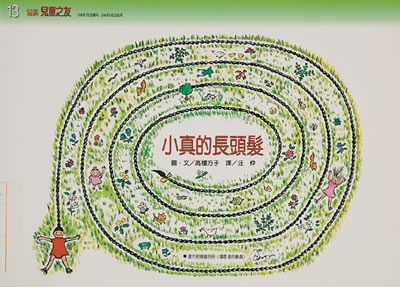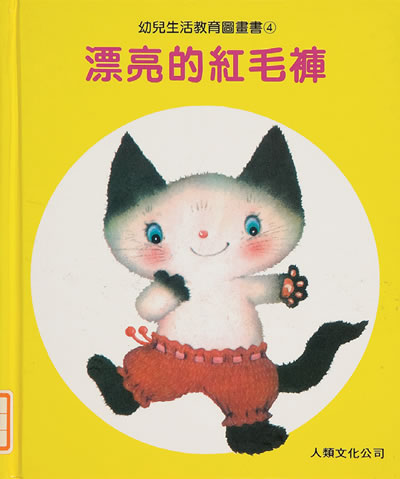Part 1 : Tower of Publication
< Chapter 2 > Countries and Regions with Many Translations of Japanese Children's Books
2nd place Taiwan
 It was not until the 1960s that Japanese children literature started to be translated for publication in Taiwan. In the mid-1970s, the number of translations gradually started to rise and the numbers grew rapidly in the late 1980s. Japanese children's books translated in the early stages included “Shukudai hikiuke kabushikigaisha” (No.41), “Kuma-no-ko ufu” (No.144), and “Katamimi no oshika” (No.42). In those days, there were not many translations, but many of them, for which several editions were issued, still enjoy popularity in Taiwan.
It was not until the 1960s that Japanese children literature started to be translated for publication in Taiwan. In the mid-1970s, the number of translations gradually started to rise and the numbers grew rapidly in the late 1980s. Japanese children's books translated in the early stages included “Shukudai hikiuke kabushikigaisha” (No.41), “Kuma-no-ko ufu” (No.144), and “Katamimi no oshika” (No.42). In those days, there were not many translations, but many of them, for which several editions were issued, still enjoy popularity in Taiwan.
Meanwhile, Japanese picture books were not introduced to Taiwan until1982, when “Kodomo no tomo,” a monthly picture book issued by Fukuinkan Shoten Publishers, were translated into the local language. The popularity of “Maa-chan no nagai kami” (No.43), a story created by “Kodomo no tomo,” still remains high. Major factors behind the publication of picture books are the advancement of color printing technology and economic growth. Japanese picture books have such a significant influence on Taiwan that “Ehon,” the Japanese term for picture books, is widely used in the country. Until 1980, a Chinese term for picture books was generally used, but since then it has been replaced by the Japanese term “Ehon,” written in Chinese characters. Picture books with a lovely and warm atmosphere, such as “Koneko-chan ehon” Series (No.44), are loved in Taiwan.




In the 1980s, various categories of Japanese children's literature, including Bildungsroman, fairy stories, nonsense literature, and nonfiction, were translated in Taiwan.
In 1992, however, there was a significant move related to copyright law in the country. Many local publishers, which had published translations of Japanese children's books without obtaining their copyrights from the original publishers, were hit hard by the legal changes and expressed reluctance to pay expensive copyright royalties. For some years after 1992, some publishers scaled down or stopped translation operations for children's literature, except for picture books. There was a sharp decline in the translations of Japanese fantasy books, while many practical books for school life and education were translated and published in the country.
In the late 1990s, there was a “picture book boom” in Taiwan. “Karasu no panya-san” (No.45) was chosen as a world-class excellent book. The boom in fantasy books, including Harry Potter that has swept the world has triggered a great deal of interest in overseas children's literature among Taiwanese people. As a result, the translations of many Japanese children's books have been published, especially in serial form or under package deal contracts. They include the Edogawa Ranpo Series (No.46), which accounts for the largest number of translations; animal series by Hatoju Muku; and the nonsense picture story book “Hare tokidoki buta” series (No.47).



Responding to the trend that an increasing number of children have less interest in reading books, the Taiwanese government implemented a project to promote book reading from 2000 to 2001. The project, called “Reading Year for Children,” aimed to promote children's reading habits at home and school. At this time, the “Nezumi-kun no ehon” series (No.48) was introduced to Taiwan by Poplar Publishing, and sequels of the book series have been translated for publication in the country.
Fairy tales targeting young school children, which are called “bridging books,” have recently increased their presence in Taiwan. For example, the “Ruru to rara” series (No.49) and “Otetsudai neko” series (No.50) have been introduced to the country. As soon as a new children's book is released in Japan, its translation is published in Taiwan, maybe because of a lower language barrier between Japan and Taiwan. With Kodansha's Aoitori Bunko paperback series, publishing contracts have been concluded by the dozen. The translations of the “Kuro majo” series (No.51) and other series have also been published.
Meanwhile, an increasing number of Japanese novels for young adults and borderless books have been introduced to Taiwan. They include “Batteri” (No.52) and “Seirei no mamoribito” (No.174).





For copyright reasons, images of some books are not available in this electronic exhibition.
- TOP
- Part 1 Tower of Publication
- Countries and Regions with Many Translations of Japanese Children's Books(2nd place Taiwan)

